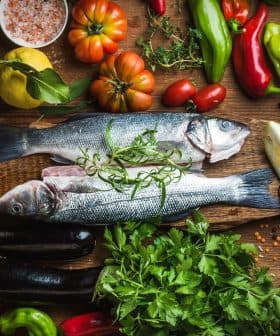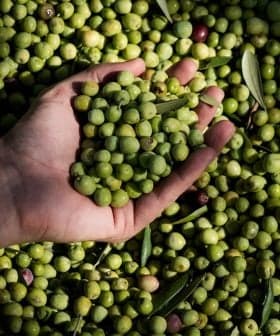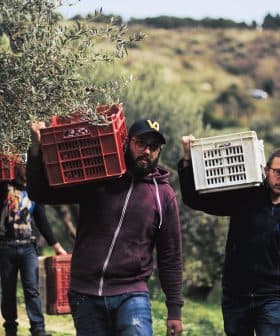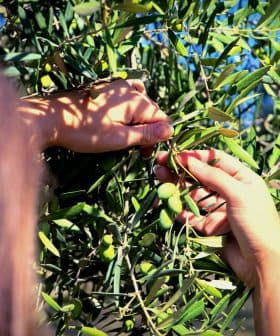Meet the Bacteria Devastating Olive Groves and Vineyards
Xylella fastidiosa, a bacterium causing plant diseases, has an annual economic impact of €5.5 billion in Europe. Its spread is linked to climate change.
 An infected olive tree is cut down in Oria, near Brindisi (AP)
An infected olive tree is cut down in Oria, near Brindisi (AP) Xylella fastidiosa is a bacterium causing plant diseases, including Olive Quick Decline Syndrome (OQDS), with an annual economic impact of over €5.5 billion. The bacterium can spread through plants via the xylem, leading to water stress and deficiencies in elements, causing symptoms of diseases, and efforts to control it focus on prevention, containment, and research into treatment methods.
One of the European Union’s top 20 priority plant pests, Xylella fastidiosa is a bacterium that causes a variety of plant diseases.
It causes the deadly Olive Quick Decline Syndrome (OQDS), which has led to widespread outbreaks in Europe over the past 15 years, and is estimated to have an annual economic impact of more than €5.5 billion.
The origins of the bacterium in Europe and globally
Xylella fastidiosa is one of only two known species of Xylella; the other is Xylella taiwanensis, which causes pear leaf scorch in Asian pears on the island of Taiwan.
An aerobic, Gram-negative bacterium that grows in the water transport tissues of plants (xylem), X. fastidiosa is known to cause numerous plant diseases worldwide.
The bacteria can travel freely through plants via the xylem, constantly multiplying as they do so.
Once their numbers reach a critical level, the resulting biofilm blocks the xylem, leading to water stress and deficiencies in elements such as zinc and iron, which cause many of the symptoms associated with the diseases the pathogen is linked to.
The first reports of such a disease occurred in 1892 when an unknown plague wiped out approximately 14,000 hectares (34,600 acres) of California vineyards.
See Also:Olive Oil BasicsThis “Anaheim disease” was later named Pierce’s disease after Newton Pierce, the bacteriologist brought in to study the outbreak.
Pierce correctly surmised that a microscopic infectious agent caused the disease, although he was unable to isolate or identify the specific agent.
Assumed to be a virus for most of the 20th century, it was not until 1973 that X. Fastidiosa was recognized as a bacterium. It was not until 1987 that the bacterium was formally described and named Xylella fastidiosa by Wells et al.
Since then, 696 plant species from 88 botanical families have been identified as suitable hosts for the pathogen.
Among the diseases known to be caused by Xylella are several of significant agricultural and economic importance. These include the aforementioned Pierce’s disease, which currently causes the California wine-making industry estimated annual losses of $104 (€92) million, olive leaf scorch and OQDS.
OQDS causes withering and desiccation of olive leaves, twigs and branches, preventing the trees from bearing fruit and eventually leading to the collapse and death of the tree.
Worst-case predictive models show total economic losses of up to €5.6 billion in Italy alone by 2070, and an estimated 100,000 jobs have already been lost due to outbreaks in the country.
Due to its destructive effects and its ability to rapidly adapt to new environments and hosts, Xylella fastidiosa is regulated in the E.U. as a quarantine organism. Its introduction into, and movement within, the union territory is prohibited by law.
How Xylella spreads and where it is currently found
Native to Central America, Xylella fastidiosa is transmitted between host plants by xylem-feeding insects from the Cicadellidae (leafhopper) and Cercopidae (spittlebug and froghopper) families.
Such insects are capable of only rudimentary flight over short distances (about 100 meters), but have been recorded traveling much longer distances when carried by the wind. Bacterial transfer has also been shown to occur below ground via root grafts.
Long-distance spread most often occurs through the movement of infected plants. This is believed to be how the pathogen was introduced to Italy and other European nations.
In October 2013, Xylella fastidiosa was found infecting olive trees in the region of Puglia in southern Italy.
This was the first time the bacterium had been reported within the European Union. The disease caused a rapid decline in olive grove yields, and by April 2015, it was affecting the whole province of Lecce and other zones of Puglia.
See Also:Australian Growers on Alert After Xylella Fastidiosa Found in ChinaThe subspecies involved in Italy has been identified as X. fastidiosa subsp. pauca, a strain that shows a marked preference for olive trees and warm climates. This subspecies has since been listed under the Agricultural Bioterrorism Protection Act in the United States because of its devastating potential.
In response to the Italian outbreaks, the European Food Safety Authority (EFSA) convened an extraordinary scientific workshop in November 2015.
More than 100 scientists from around the world attended the event to identify major knowledge gaps and discuss research priorities regarding the pathogen.
During the same month, the EFSA concluded from ongoing experiments in Puglia that grapevines were a possible reservoir of Xylella in the region.
By October 2015, the pathogen had reached Provence-Alpes-Côte d’Azur on the mainland of France, where the subspecies X. fastidiosa subsp. multiplex was found to have infected myrtle-leaf milkwort, a plant species introduced from South Africa.
The following year, the bacterium was identified in Corsica and Germany. In 2017, it was detected on the Spanish islands of Mallorca and Ibiza, and subsequently on the Spanish mainland.
Xylella has since been found in olive trees and other host plants across the Iberian Peninsula, as well as in Lebanon and Israel in the Middle East.
The role of climate change in Xylella’s spread
Substantial research indicates that climate change increases the risk of plant disease outbreaks, with changes in temperature and humidity being the primary drivers.
As global temperatures rise, the geographic range of many pathogens expands, exposing new regions and plant species to diseases previously restricted to warmer climates.
Higher temperatures are generally conducive to the proliferation and propagation of fungal and bacterial species, especially when combined with elevated humidity.
Additionally, higher minimum temperatures extend the seasonally active period of organisms and increase their ability to survive the winter and persist in the environment. This applies not only to pathogens but also to their vectors.
In addition to favoring many pathogens, higher temperatures can weaken a plant’s natural defensive mechanisms through processes such as heat and water stress, making them more vulnerable to infection and more likely to suffer greater damage and higher mortality rates.
Specifically regarding Xylella fastidiosa, a recent climate-driven epidemiological model analyzed the vulnerability of European lands to the disease in different climate change scenarios by assessing the climatic conditions favored by both the pathogen and its primary vector, Philaenus spumarius, also known as the meadow froghopper or meadow spittlebug. This insect has previously been identified as the vector responsible for spreading the bacterium in Italian olive groves.
The study found that a global mean temperature rise of 1.5 °C increases the percentage of total land area at risk in Europe to 0.32 percent, while a rise of 4 °C increases the area to 1.87 percent.
Within the range of temperature increases analyzed, a tipping point of a 3 °C increase was identified. Beyond this threshold, the researchers found that the risk of the pathogen spreading north of the Mediterranean region becomes remarkably higher, allowing it to spread rapidly into previously unaffected areas.
The authors also assert that before the mid-1990s, European climatic conditions, except those of the Mediterranean islands, most likely prevented the bacterium from establishing itself on the continent.
Efforts to control Xylella fastidiosa
As there is no known cure for diseased plants, current control measures focus on prevention and containment.
The most effective strategy in common use requires both the comprehensive removal of infected plant matter, which can act as a reservoir for the bacterium, and the control of insect vector populations.
In addition to the complete removal of plant matter known to be infected, the EFSA recommends creating a “buffer zone” of at least 100 meters from which all susceptible plant species are also removed and destroyed.
See Also:Revitalizing Salento — Entrepreneurs Fight Xylella with New IdeasDue to the virulent nature of the pathogen, experts recommend using protective measures when removing and transporting all organic material during this process.
The process of controlling insect vectors is similarly involved, requiring not only the elimination of the organisms themselves but also their habitats.
This is necessary due to the polyphagous nature and multi-stage lifecycles of such insects. Philaenus spumarius, for example, is known to feed on at least 170 host plants and develops through five separate stages after hatching.
Treatment and research for Xylella fastidiosa
Combinations of changes in cropping methods, bactericidal treatments, and interventions aimed at enhancing the physiological state of the host have shown promise in impacting disease development, even to the point of allowing harvesting to resume. To date, however, none have proven successful at eradicating the pathogen in an infected plant.
Research into treatment methods is severely curtailed by Xylella’s quarantine status, especially within the E.U. Other EU restrictions include the prohibition on using antibiotics for plant protection. Fields of research, therefore, vary from one geographical region to another.
In the United States, where antibiotic use is authorized for use in plants, information is available from trials of antibiotics such as oxytetracycline, tetracycline and streptomycin in the foliar treatment of Pierce’s disease and of microinjection of oxytetracycline in the treatment of Xylella-induced leaf scorch in American elm.
See Also:Xylella-Resilient Groves Are the Future of Apulian Olive OilAlthough such trials have demonstrated remission of symptoms, none have succeeded in eliminating infection, and symptoms returned after treatment was stopped.
A major initiative within Europe is the Biovexo Project, a Bio-Based Industries Joint Undertaking (BBI-JU) Innovation Action launched in 2020 under the European Union’s Horizon 2020 research and innovation program.
Aimed specifically at combating Xylella in olive cultivation, BIOVEXO is developing two main classes of environmentally-friendly biopesticides: “X‑biopesticides,” which target the pathogen directly, and “V‑biopesticides,” which target the spittlebugs that act as the pathogen’s primary transmission vector.
The component substances being trialed are bacterial strains, a microbial metabolite, plant extracts and an entomopathogenic fungus.
In a novel approach, recent research in Brazil involves N‑acetylcysteine, a common mucolytic drug used to treat paracetamol overdose and to loosen thick mucus in human cases of disorders such as pneumonia and bronchitis.
While the mechanisms responsible are not yet fully understood, initial results have shown the effectiveness of the drug in disrupting bacterial biofilms when applied by irrigation to hydroponic or field crops.
Given the role that biofilms play in protecting bacteria against antimicrobial treatments and ultimately leading to bacterial resistance, this area of research may be on the rise, as breaking down the protective biofilm matrix could significantly increase the effectiveness of treatments targeting the Xylella bacterium directly.
Until a means is found to accurately and systematically kill the pathogen throughout its host, as this research suggests might one day be possible, quarantine and destruction of infected plants will likely remain the single most effective method of control.
Know the Basics
Things to know about olive oil, from the Olive Oil Times Education Lab.
Extra virgin olive oil (EVOO) is simply juice extracted from olives without any industrial processing or additives. It must be bitter, fruity and pungent — and free of defects.
There are hundreds of olive varieties used to make oils with unique sensory profiles, just as many varieties of grapes are used in wines. An EVOO can be made with just one variety (monovarietal) or several (blend).
Extra virgin olive oil contains healthy phenolic compounds. Substituting a mere two tablespoons of EVOO per day instead of less healthy fats has been shown to improve health.
Producing high-quality extra virgin olive oil is an exceptionally difficult and costly task. Harvesting olives earlier retains more nutrients and extends shelf life, but the yield is far less than that of fully ripe olives that have lost much of their healthy compounds.
Share this article









